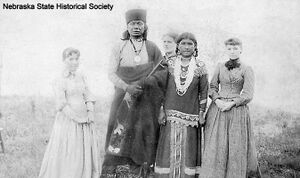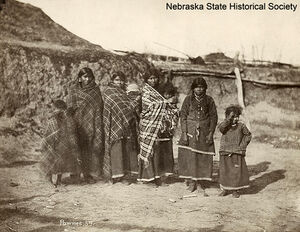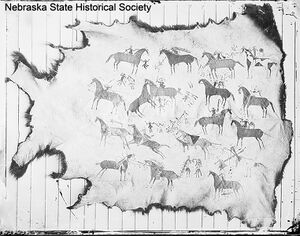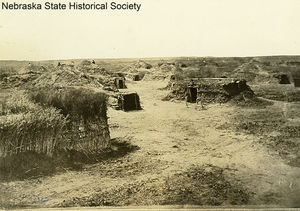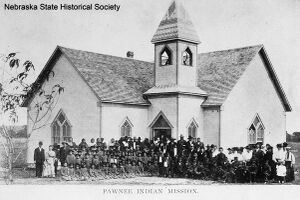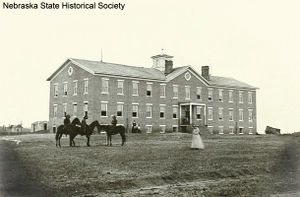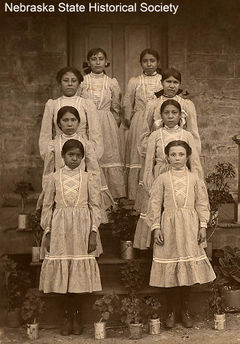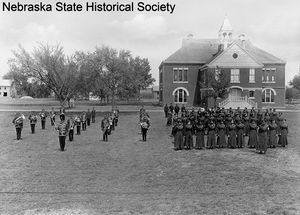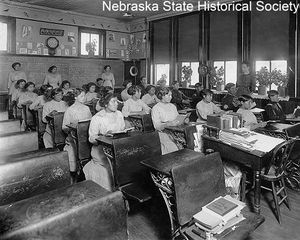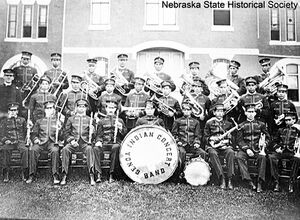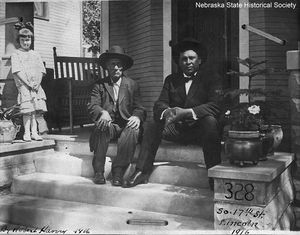Template:Pawnee
Pawnee in Nebraska
Residents of what is now Nebraska for hundreds of years before white settlers arrived, the Pawnee have likely lived in Nebraska longer than any other current tribe.
Origins
The Pawnee came to the Great Plains earlier than other Great Plains tribes did. While many tribes associated with the Plains, like the Sioux, migrated to the Great Plains within the last few centuries, the Pawnee have lived in the region since at least the 1500s and possibly longer. There is some evidence that the Pawnee lived along the Republican and Loup Rivers between 1100 and 1400. The Pawnee language comes from the Caddoan language, meaning they are linked linguistically to the Caddo, Wichita and Arikara peoples. Because of this, it is believed the Pawnee were originally part of the Caddo people, who lived in the southern Great Plains (Texas and surrounding states), but migrated north. A part of this band became the Wichitas. Linguistic evidence suggests the Pawnee and Wichitas became separate tribes in the first few centuries A.D.
Early History
The Pawnee separated into four mostly independent bands: the Skiri, Chaui, Kitkahahki and Pitahawirata. The Skiri and Chaui seem to be the oldest of these bands; evidence of their settlements in villages near the Loup River (Skiri) and Shell Creek (Chaui) date to before the 1700s. The Chaui eventually spread to the Platte River and Skull Creek. The Kitkahaki and Pitahawirata split off from the Chaui some time before 1750. These bands were kept independent because marrying outside of one’s village was seen as upsetting the cosmic order. During the later 1700s, westward migration of white people pushed Indian tribes west of the Appalachians closer to the Great Plains. The combined threat of rival Indian tribes and white settlers caused the Pawnee to build bigger settlements. Each of the four Pawnee bands consolidated into one large village or town.
Traditions and Religion
Each of the four bands had its own take on Pawnee religion, but they shared some characteristics. The Skiri believed that the stars were transformed gods or fallen heroes. Skiri ceremonies were thus based on celestial movements. Unlike the other bands, the Skiri allowed anyone to join their ceremonies, even those not a part of their band. One peculiar Skiri tradition was the Morning Star Ceremony. The Skiri believed that human beings came from the marriage of the Morning and Evening Stars. The ceremony involved a reenactment of the marriage and included the sacrifice of a captive woman. It is one of the few cases of human sacrifice practiced by Indian tribes north of Mexico. The other three bands had no such ceremony. They focused their beliefs on animals. All the Pawnee attributed supernatural powers to Ti-ra’wa, the mysterious life force of the universe. They also venerated corn, as they had a history of farming. The Skiri had a ceremony based on corn called the Corn Planting Ceremony, which was comprised of dances mimicking corn planting and hoeing coupled with songs about fertility.
Like other Plains Indians, the Pawnee attached special meaning to the land. Fourteen sites are said to be sacred to the Pawnee, though only five of those have been found. Each of these places contained the lodges of the nahu’rac, animals with supernatural powers that were the gods’ representatives on earth. These animals could kill but could also cure disease, among other things. Groups of doctors in Pawnee society were named after the animal from which they received their power. Pawnees would visit these sacred sites to make offerings to Ti-ra’wa and to seek visions. The most sacred place was Pa:haku, located near Fremont. All the sacred sites except one were located between the Loup and Republican Rivers- the traditional Pawnee homeland.
Subsistence
The Pawnee had a largely agriculturally-based food supply. Corn was the most important crop, but beans, pumpkins and squash were also grown. The Pawnee developed 10 different types of corn, 7 types of pumpkins and 8 types of beans. Pawnee society was ordered around harvest cycles. The harvest season was filled with feasts and celebrations. In addition to farming, the Pawnee hunted buffalo. The arrival of horses made buffalo hunting easier, so after 1800 buffalo meat replaced corn as the main staple of the Pawnee diet. When the harvest was slim and buffalo were scarce, the Pawnee would gather wild fruits, nuts and vegetables. These wild foods remained a part of the diet in good years, too.
Raids
Fights between Plains Indian tribes were a normal occurrence, but it was not exactly warfare. Instead, groups of men from one tribe would raid a village from another tribe mainly for plunder. Raids formed a critical component of Indian society. Success in raids could promote a man in the hierarchical structure of society, bringing them wealth and status. In some cases, raids could also be ways of exacting vengeance on other tribes. The Pawnee were generally belligerent with most tribes in the area, though they were usually at peace with the Arikara and Omaha.
The Villasur Expedition
See main article: The Villasur Expedition One of the first appearances of the Pawnee in the historical record (and, indeed, one of the first appearances of what would become Nebraska) was a battle between Spanish forces and the combined forces of the Otoe and Pawnee tribes. On August 14, 1720, Sir Pedro de Villasur of Spain, the leader of a military expedition into the Great Plains, was attacked by the Otoe and Pawnee. His force was annihilated. The battle ended Spain’s hopes of extending its power into the region.
Contact
Contact with European-Americans had significant effects on the Pawnee. Waves of epidemics, especially smallpox, severely diminished the Pawnee population. Significant epidemics occurred in 1800-1801 and 1837-38. Horses provided one positive result of contact; by 1714, the Pawnee had horses in their possession, which increased their ability to hunt, trade, and raid. Horses were much more useful for hauling loads than dogs, which Plains Indians had previously used. However, horses also made it easier for the belligerent Sioux bands to attack other tribes, including the Pawnee. Other goods from the whites, like kettles and cloth, also changed Pawnee working traditions. While many other tribes also traded for alcohol, the chiefs of the Pawnee were successful in keeping alcoholic drinks from their bands for much of the 1800s.
The fur trade also had negative effects on the Plains Indians. The Pawnee were not as involved in the fur trade as some of their neighbors, but the trade affected them as well. New technologies acquired in the trade weakened old traditions. Fur traders sometimes meddled in tribal politics. Their wealth could give them power greater than the chiefs. Also, their presence in the Great Plains, along with their constant demand for furs, depleted the resource base of the region. Overhunting, which became especially problematic as more white settlers moved into the region, caused the Pawnee to travel farther to hunt buffalo. The wealth and thus the power of the Pawnee decreased while the Sioux, who had a more profitable fur trade, were able to acquire more wealth and weapons.
Missionary Efforts
In the 1830s, Christian missionaries worked among the Indian tribes. Christianization and Americanization were tightly linked; missionaries worked not only to convert the Indians to Christianity but also to American ways, like individual farms. John Dunbar was a missionary who worked with the Pawnee during this time. He attempted to learn the Pawnee language and by 1845 was able to translate parts of the Bible into Pawnee. Despite his efforts, few Pawnee converted, as they were very attached to their old ways.
The missionaries, while they had little respect for Indian culture, sought to protect the Indians from harm. During times of famine and sickness, the missionaries’ supplies of food and medicine helped the tribes stay alive. They also saw their Americanization work as humanitarian; if the Indians didn’t adopt white ways, the settlers and the military who were soon to move into the region would surely cause worse damage than the loss of cultural heritage. Thus, the missionaries were often the only whites the Indians trusted.
Land Cessions
In 1833, the Pawnee signed a treaty with the government agreeing to cede all their land south of the Platte River in return for annuity payments. The Pawnee could still use the land south of the Platte for hunting (as long as the President would allow). The Chaui, whose primary residence was in this ceded land, were forced to relocate north. In total, the Pawnee received $148,200, or 1.1 cents an acre, for their land. This money came partly in annuity payments and partly in education funds, agricultural funds and supplies, including weapons. Most annuity payments came in the form of supplies rather than cash. However, these supplies were often poor-quality merchandise, arrived late and weren’t worth the full value of the annuity. Furthermore, they were not always distributed evenly amongst the tribe; chiefs usually ended up with the best supplies.
The Pawnee and Westward Migrants
The Platte River became the main highway for emigrants heading towards California and Oregon during the 1840s, meaning every year hundreds or thousands of white settlers passed through Pawnee territory. The emigrants depleted the area’s supply of wood and grass. At the same time, bands of Dakota Sioux, armed with weapons given to them by the government as peace offerings, raided Pawnee villages. Thus, the Pawnee often had to resort to begging or stealing food from the travelers.
The government responded by building Fort Kearny, near the modern-day city of Kearney, in 1848. The fort was designed to protect migrants against hostile Indians and promote tranquility amongst the Indians. The fort’s location was selected to “overcome the audacity” of the Pawnee, in the words of Lt. D.P. Woodbury, the officer in charge of placing the fort. The government paid the Pawnee $2,000 for the 110,000 acres of land that became Fort Kearny and its surrounding military reservation.
While the Pawnee had a reputation amongst travelers as violent and hostile, they actually caused few disturbances. Most, if not all, of the fatalities caused by conflicts between the Pawnee and the whites were actually Pawnee casualties; in one case, a Pawnee chief and his wife were killed when they tried to beg for food. The one band of Pawnee that did cause problems was the Chaui. Many of them refused to move north. They enjoyed their southern location because it was closer to hunting grounds and trails to raid while also being farther from the Dakota. They sometimes turned their anger against the other Pawnee; several groups of Chaui raided the Pawnee mission village to kill animals.
More Problems
By 1843, more than half the Pawnee lived in villages near Plum Creek, where John Dunbar centered his Americanization program. On June 27, 1843, 500 Dakota attacked the Plum Creek village. The Skiri, who lived near the Plum Creek village, watched in horror. Their reluctance to help the other Pawnee soured their relation with the other bands for a long time. Some Chaui came in to help, their animosity towards the Dakota being greater than their anger at their fellow Pawnee. In all, 67 Pawnee were killed, many of them women and children.
The Dakota also abused the Pawnee living south of the Platte. In 1849, the same year the cholera epidemic brought by westward migrants hit the plains, the Dakota destroyed the Chaui village. Now all the Pawnee were homeless. Dakota attacks, battles with other tribes, disease, poor harvests and the lack of buffalo greatly damaged the Pawnee population. In one six-month period in 1849, 1,234 Pawnee died. At least 50 percent of the Pawnee population died between 1825 and 1855.
As the population of the Pawnee dwindled, traditions began to go by the wayside. Intermarriage between the bands became accepted. New technologies from the whites disrupted traditional practices. The chiefs wanted to maintain peace with others while the warriors wanted to continue traditional raids. The Morning Star Ceremony was last practiced by the Skiri in 1838, and the Corn Planting Ceremony died out in 1856. Despite this, the Pawnee remained the most powerful and wealthy tribe in Nebraska. Over 3,400 Pawnee lived in Nebraska Territory in 1861, more than any town in the territory at the time. They also had more horses and more warriors than any other tribe.
The Kansas-Nebraska Act
Passed in 1854, the Kansas-Nebraska Act opened up lands west of the Missouri (Kansas and Nebraska Territories) to white settlement. The coming of white settlers into this land, formerly reserved for Indians, would require the government to take more land from the Indians. Displaced Indians would be put on reservations, where the government would watch over them and guide them in the Americanization process.
The Pawnee Reservation
As whites moved into the area during the 1850s, conflicts inevitably arose between settlers and the Pawnee. When the chief of the Chaui, Te-ra-eta-its, and one of his companions went to a white man’s house to beg for food after their horses were stolen by other settles, the man who owned the house shot and killed the chief. The settlers, fearful of more violence, called on the government to remove the Pawnee. The Pawnee said they would have accepted a reservation south of the Platte and away from the Sioux, but the government insisted they get one near the Loup River. On September 24, 1857, the Pawnee signed a treaty creating a reservation in modern-day Nance County, just west of Columbus. While the tribe received more money per acre than they had in their 1833 treaty, they still received very small payments. In the first five years of the treaty, they received only $6 per person in direct payments.
In 1859, $10,000 was deducted from their annuities when a band of Pawnee terrorized settlers along the Elkhorn River. Four Pawnee died during the raids, and no whites were killed. Even though the Pawnee’s Indian Agent cautioned that many claims might have been fabricated, the government still punished the Pawnee for the full amount. In 1857, a group of Mormons established the town of Genoa on land that would become part of the Pawnee Reservation. They were forced by the government to move off the land in 1860. The land the Pawnee were left with was generally good land, with 1,000 acres ready for cultivation by 1861. The Skiri, the largest of the four bands, occupied two villages to the west while the other three bands together occupied another village. Fears that the reservation was open to attacks from the Sioux were quickly realized. The villages were attacked eight times in the first year of the reservation; 13 Pawnee were killed in the fights. The government offered little protection. While the Pawnee did manage to fend off one invasion of Cheyennes in 1860, they were little match for the well-armed and numerous Sioux.
The Pawnee in the 1860s
Attacks, famine and inept governance greatly weakened the Pawnee reservation over the course of the 1860s. The population declined from 3,414 in 1861 to 2,325 in 1870. Ten thousand dollars were allocated to the tribe for the construction of a manual labor school, where the Pawnee could learn modern farming techniques. The school was built in 1866. However, the Pawnee resisted changing their farming methods, and, indeed, their crops often grew better than the ones planted by agency employees.
Another key component of the reservation was the Indian school. The law demanded that every child between 7 and 18 go to school. The Indian school was designed to acculturate and segregate Pawnee children since the adults were deemed too difficult to Americanize. Despite the mandate of the law, only 79 children went to school in 1870. This was partly because the school had to give the students clothes, food and lodgings, and funding cuts made it difficult to accommodate any more students. Also, the Pawnee resisted the acculturation the school represented. They wanted to keep their traditions and not have their children cut off from them.
The Pawnee provided warriors to the US Army to fight against the Sioux and Pawnee in 1864-1866 and 1868-1869. This further enraged the Sioux, who continued raiding the Pawnee without government reprisal throughout the decade. On March 22, 1869, a group of soldiers attacked some Pawnee who had recently been honorably discharged from service in the US Army. Nine Pawnee were killed, and the remaining five escaped with their possessions stolen and found later frostbitten and near death. Six of the dead Pawnee were decapitated, and their heads were sent to Washington for “scientific study.” The soldiers were never charged. In May of that year, a white man was found dead near a Pawnee settlement. The government demanded that the Pawnee hand over the suspects, but they refused unless the government acted on the massacre of Pawnee. The government refused and took 8 Pawnee in custody. Four of them were charged, though their convictions were eventually overturned during a two-year court battle. They were released in 1871.
The Battle of Massacre Canyon
Main article: The Battle of Massacre Canyon
The last battle fought between Indian tribes in the United States was the Battle of Massacre Canyon, fought on August 5, 1873. A group of Pawnee were encamped near the Republican River at the conclusion of the last successful buffalo hunt. They were attacked by Sioux unexpectedly, leaving over 60 Pawnee dead.
Removal
There remained 2,447 Pawnee in 1872, only 38.4% of the 1840 population. The gap between males and females was immense given the frequent warfare, and disease decimated the adult population; 43.4% of the population consisted of children. The same problems that had plagued the Pawnee for decades continued to wear them down. Matters only got worse in the 1870s. Settlers cut down trees on Pawnee land with impunity. The annuity payments were reorganized, giving the Pawnee less control over their resources. On May 2, 1873, the Pawnee were forbidden to leave the reservation without a pass. In 1873, between one-fifth and one-fourth of the Pawnee left for the Wichita Agency in Indian Territory. The Wichitas told them that their land was plentiful with game, and the poverty of the Pawnee land drove many from it. A grasshopper infestation the following year convinced the rest that moving south would be beneficial for the tribe. On October 8, 1874, the Pawnee agreed to a treaty agreeing to move to Indian Territory to live in a site of their choosing. The Pawnee left in waves, beginning in the fall of 1874; the last group did not leave until October of 1875. At first, the Pawnee lived with the Wichitas, but in June of 1875 they moved to their own reservation 150 miles away.
In Indian Territory
As it turned out, the land in Indian Territory was even worse than the Pawnee’s land in Nebraska. Disease was rampant. Between 1876 and 1885, half the population of the Pawnee was lost. Their culture began to disappear as well. The various ceremonies celebrated by the Pawnee were based on the cycles of weather and harvest. These traditions were hard to maintain in the new climate of Indian Territory.
Allotments
The Dawes Act was passed in 1887. This bill forced Indians on reservations to accept individual allotments of land, replacing the communal ownership of the reservations. Each family would be given a certain amount of land, and all the excess land in the reservation would be sold. The Pawnee were not put on allotments until 1893. So few Pawnee remained at that time that well over half of their reservation was sold as surplus land. They were given an advance of $80,000 for the land, which was sold for $212,916.71; the $132,916.71 of remaining money was not given to the tribe until 1920. The move to allotments did not help the Pawnee prosper. By 1900, only 650 Pawnee remained.
The Pawnee in the 20th Century
The “Indian New Deal” of the 1930s sought to give tribes more control over their own affairs by allowing tribes to create their own governments. The Pawnee set up a government under the Oklahoma Indian Welfare Act in 1936. Between 1946 and 1962, the Pawnee were awarded $7,316,096 in return for lands bought from the tribe for “unconscionably” low prices. The Pawnee are still governed by their tribal government located in Oklahoma.
Bibliography
Jackson, Donald, “Zebulon Pike and Nebraska,” Nebraska History 47 (1966): 355-369
Parks, Douglas R., “Bands and Villages of the Arikara and Pawnee,” Nebraska History 60 (1979): 214-239
Wishart, David J. An Unspeakable Sadness: The Dispossession of the Nebraska Indians. Lincoln: University of Nebraska Press. 1994.
Wishart, David J., “Pawnees” in David J. Wishart, ed. Encyclopedia of the Great Plains. Lincoln: University of Nebraska Press, 2004, 590-591.
